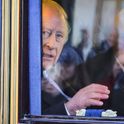"Nothing done by government has changed the nation more than loosening immigration relations": a 2008 citizenship ceremony in London (© Getty Images)
On 19th April 2001, the foreign secretary Robin Cook gave an address on national identity to the Social Market Foundation that has always since been known as “the chicken tikka masala” speech. Cook had chosen a vivid metaphor for a familiar multicultural theme: when cultures collide, the mixture can produce something different from both and superior to either. In this case, the desire of the people of Glasgow to have their chicken tikka covered in gravy created chicken tikka masala.
I recall this speech not just because a decade has elapsed and another census from the Office for National Statistics has recently been published, posing again the question of what kind of people the British are. It is also because, in an event so corny that it could have been staged to provide an opening for an article on British identity, I met my Indian wife that evening. Our children will be delighted to know that I consider that union produced something both different to and superior to either.
Ten years on, how are we all doing? The results from the 2011 census, compiled in March 2011, brings to mind George Orwell’s point that the fading figure in the photograph on the mantelpiece every day bears less and less of a resemblance to the you who is looking at it, apart from the fact that you happen to be the same person. Britain has changed and aged in the decade between 2001 and 2011.
The population of England and Wales has reached 56.1m, up by 3.7m in a decade, which is the largest growth shown by any census since they began in 1801. Half the increase was due to net migration. The other half is attributable to the fact that, between March 2001 and March 2011, the 5m deaths were more than cancelled out by 6.6m births.
The nation which emerges from the 2011 census is one which is more diverse, less religious and older than it once was. It is one which faces five serious questions, all of which are contained in the data, there to be discovered by any politician brave enough to confront them.
The first question is a fundamental, tectonic shift. Politics is no longer anchored to other questions of identity. There was a time when religious affiliation was a reasonably good proxy for political allegiance but that time has long gone. Indeed, religious belief itself is suffering a steady fall. The number of people in England and Wales who described themselves as Christian fell from 72 per cent to 59 per cent over the past decade and a quarter of all people, 14m of us, now say they have no religious affiliation.
This is largely not a function of immigration. Despite common fears about “Londonistan” or reports that Leicester, for example, is on the verge of having a Muslim majority, Britain is not becoming a non-Christian religious nation. The second largest religious group in England and Wales is Muslims, who make up 4.8 per cent of the population.
The 19th century anchoring role of religion was replaced, in the 20th century, by social class. In 1906 there were two events which, it turned out, had chronic significance. The first saw the Labour party take on its modern form and the second was the decisive victory of the Liberal party in the general election; “from that victory,” in George Dangerfield’s justly famous verdict, “they never recovered.” From then on, politics became locked into social blocs organised around stable industrial trades. There were always exceptions and marginal seats, but working class and urban areas were usually red and middle class and rural areas were usually blue.
In the long era of two party politics that ran from the 1920s to the collapse of the post-second world war consensus in 1974, each party could come close to victory by mobilising its own bloc. It didn’t require too many voters to cross the class lines to bring about an overall majority in parliament.
The re-emergence of nationalism in Scotland and Wales and the rebirth of the Liberals as a third party in the nation altered the political arithmetic. The 2011 census shows how. Thirty per cent of the population now works in a professional or technical capacity which, in a sentence, is the explanation of the need for New Labour. The rationale for a compassionate Conservative party is also obvious when almost a quarter of the population work in health, social work and education. In other words, neither party is able to assume that victory is possible by getting its natural vote out.
There is also a warning for the Conservative party in the fact that half of the population increase of the past decade was due to migration. People born outside the UK overwhelmingly vote Labour. The Tories need people to vote as, say, entrepreneurs rather than as, say, Indians, as they do now.
The big political challenge here is that the parties are, inadvertently, running in the opposite direction, back to their heartlands. Neither David Cameron nor Ed Miliband is the sort of transformative figure capable of bringing over voters from the opposing tribe in sufficient numbers. The upshot of austerity is that Cameron is leading a party popular in the rural south of England and Ed Miliband, by opposing so vigorously, is strengthening his position in the industrial north of England, without either ever threatening to break out.

The second big political question evident in the 2011 census is that something is stirring in the argument about immigration. The most conspicuous change over the last decade has been that Robin Cook’s thesis from April 2001 has been put substantively to the test. Not since 1066 has Britain truly been a nation of immigrants. When historians write the domestic story of the Blair years, immigration will be the largest legacy. Nothing done by government has changed the nation more than the decision to loosen immigration regulations.
In 2001 there were 4.6m residents (9 per cent) of England and Wales who had been born outside the United Kingdom. Now there are 7.5m (13 per cent). Even these bald numbers understate the scale of the change, due to the churn as some foreign-born nationals have left during the last decade. Half the foreign-born people who live in England and Wales have arrived in the last decade. That’s some 3.8m people.
This change has arisen for two reasons. Family members have continued to come in from India and Pakistan. Then there has been a nine-fold rise in the number of Poles since the accession of Poland to the EU in 2004 and Britain’s decision to permit free movement immediately.
The argument about immigration almost always breaks out as a demand that immigrants speak English. In fact, they do. In 91 per cent of households, everyone speaks English and there are only 4 per cent of the 23.4m households in which nobody has English as a main language.
A consensus seems to have arisen even amidst the furious dispute that the previous Labour government’s more open door policy was wrong and that the correct response is to get tougher. The Conservative party has taken fright at the issue because UKIP is snapping at its electoral base. The paradox of UKIP’s appeal, as a party obsessed with the European Union, is that its supporters don’t care much about Europe. They come towards UKIP because they find Nigel Farage and his merry men sympathetically hostile on immigration. It’s not just the Conservative party. Ever since Gillian Duffy accosted Gordon Brown in a Rochdale street during the 2010 general election campaign, Labour has been inching towards a more closed position on immigration.
The third big unanswered question is what to do about the fact that Britain is getting older. A full 16 per cent of the nation is now aged 65 or over, the highest figure in any census, whereas only 6 per cent are under five years of age. Were it not for immigrants, who tend to be young, this number would be even smaller. Likewise, the increase in the numbers of people in their 20s is accounted for by net migration.
David Willetts is fond of pointing out that to be old was once a good proxy for being poor, but no longer. Pensioners are now no more likely to be poor than members of the general public. Yet the welfare system has evolved on the assumption that old age is likely to be a time of poverty. There is a residual sense that people who have paid in when young ought to draw something out when old and retirement did not last as long when Beveridge was drawing up the blueprint for the welfare state in 1942.
Democratic politics in mature societies is notoriously bad at dealing with long-term problems. The political cycle rarely makes it worth the while of any given leader to tackle a problem whose consequences will be visited on one of his successors. Even if he solves the problem, the credit will not come in for many years after the end of his own career.
Hence, the political logic to delay action on social care even though one in ten people provide unpaid care for someone with an illness or disability and almost one in five say they have a limiting illness. We still await a plan for how the National Health Service can cope with the prevalence of long-term conditions that threaten it with bankruptcy.
The 2011 census tells us that these problems cannot be avoided forever. Sooner or later a leader is going to have to accept that, whether or not the grey vote is very powerful, the country cannot afford the winter fuel allowances, free bus travel, television licences and Christmas bonus it is paying out to all its pensioners.
The fourth big question raised by the 2011 census is housing. The most recent, most sudden and most unexpected weak point of the post-war political settlement has been the unintended and unwanted demise of the dream of home ownership. The number of households with a mortgage fell, over the last decade, from 39 per cent to 33 per cent. For the first time since records began in 1951, home ownership fell, from 69 per cent to 64 per cent. As the price of property became unaffordable for many people, private renting recovered the share it once had in 1910. Fifteen per cent of people are now in private rented housing, a rise from 9 per cent just 10 years ago. Incomes are falling and the great dream of advance represented by home ownership is in retreat. The political reality of this is one that no party has yet acknowledged.
The fifth question is rebalancing. There is a vibrant political debate about whether the British economy, and especially the Exchequer, became excessively reliant on the tax revenues that flowed from the City of London. However, it is proving a good deal easier to point this out than it is, in a country with intrinsically high labour costs, to do anything about it.
There is, though, an increasing national imbalance in another sense that was highlighted by the 2011 census. There is a case now, financial, social and ethnic, for treating London as a separate island within England rather than as a part of it.
There is no dimension of life on which London is typical of the nation of which it is the capital city and centrifugal force. Eighty-six per cent of the nation is ethnically white but only 60 per cent in London. Eighty per cent of England and Wales are white British but only 45 per cent of Londoners. Across England and Wales, the 10 local authorities with the highest proportions of both non-UK born and non-UK nationals in their resident population are all London boroughs. A third of the capital’s population is now foreign-born and a quarter are non-UK nationals. In the northeast, just 5 per cent are foreign-born and in England and Wales 13 per cent.
The growing divergence of London from the rest of the nation poses a defining question of identity and national destiny. London is a global, open, trading city. It has taken in the huddled masses of the world and that policy has brought with it great enterprise and some attendant problems. Does Britain now want more of the same, or does it want to gently push the door closed?
It is worth pointing out, that for all the soul-searching on the question of immigration, Britain is a nation that still works. Mixing, of the most intimate kind, is proceeding nicely. Mixed race people account for 2.2 per cent of the population of England and Wales, up from 1.27 per cent in 2001, and 12 per cent of households had partners or household members from different ethnic groups, up three points from 2001.
A secure national identity is also holding up well. 91 per cent of the resident population happily identified with at least one of the available national appellations—English, Welsh, Scottish, Northern Irish or British.
Take London out of the nation and it would be a more conventional but less prosperous nation. In the debates about immigration, and Europe in particular, it seems that this is precisely what politicians want—a nation detached from the world yet somehow enjoying its fruits. The 2011 census posed two serious questions. The first is the question of which nation we now want to be. The second is whether we have the political courage to deal with the problems thrown up by the nation we are anyway becoming.














